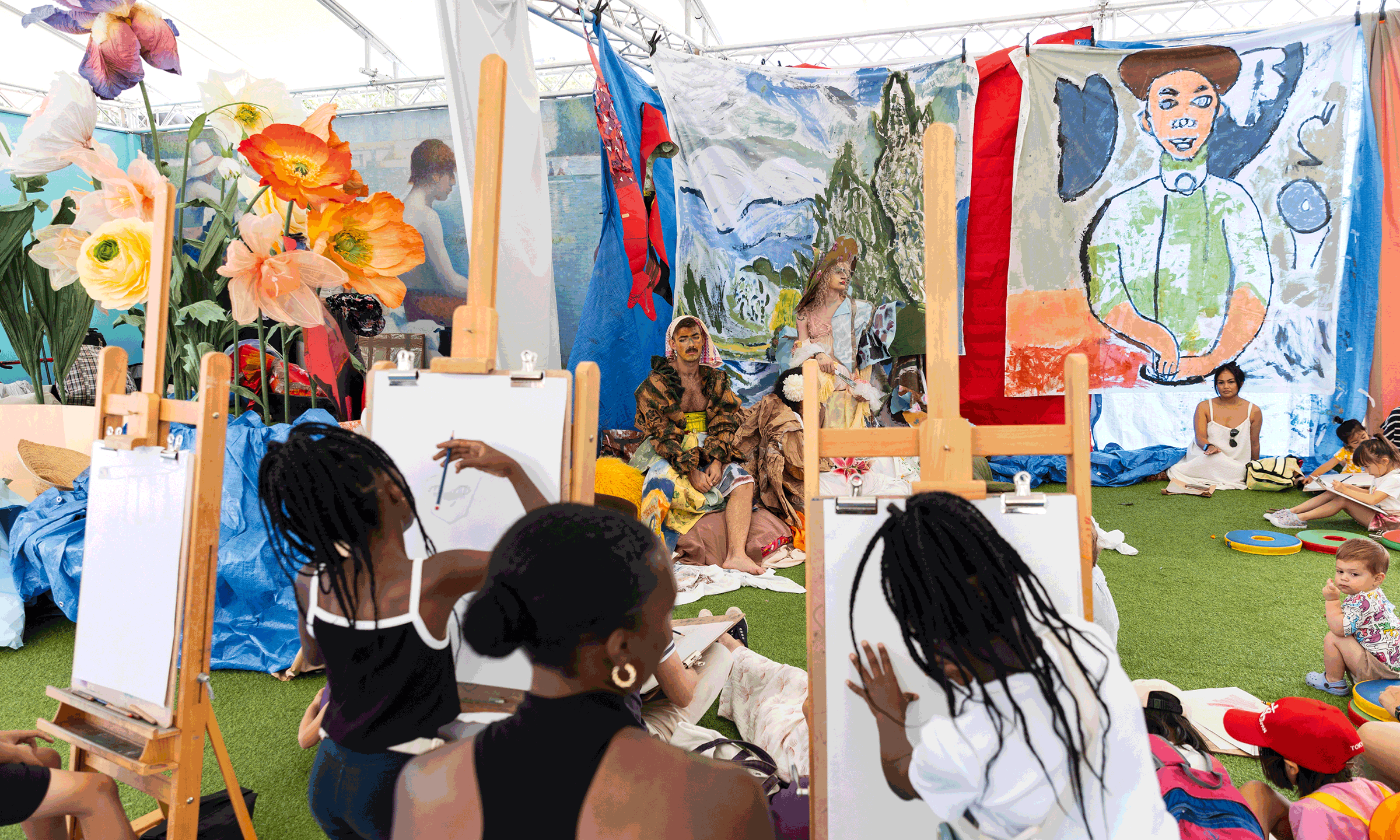Summer on the Square is a programme of free creative sessions and activities outside the National Gallery which returned in August 2024 © Ellie Kurttz
Home to masterpieces ranging from the Middle Ages through to Van Gogh’s Sunflowers, the National Gallery covers 800 years of human history and artistic ingenuity. “It’s such an amazing opportunity for all of us to connect to the processes, the history, all the stories and characters,” says Karen Eslea, the gallery’s head of learning and national programmes.
But with its grand neoclassical building and halls of Old Master paintings, the National Gallery can also be perceived by some as “not for them” or “kind of stuffy”, she says. Then there is the sheer geographical distance that separates the gallery in London’s Trafalgar Square from communities around the UK.
Breaking down those barriers is a large part of the job for the learning department, which runs creative workshops and activities inspired by the collection for audiences of all ages, from pre-schoolers to older adults, families to school groups. “It’s a national collection, so we have a responsibility for everyone to have the opportunity to explore and engage with it,” Eslea says.
More than 250,000 people participated in the gallery’s learning programmes in person, online and in locations around the UK between April 2023 and March 2024. The number rose by more than 100,000 compared with the previous year, Eslea notes, marking “significant growth in the ambition and reach of the programme”.
Karen Eslea jezsmithphotography.com
She anticipates a further “step change” early next year when the gallery will unveil its new Centre for Creative Learning as part of the NG200 bicentenary celebrations. A complete rethinking of the former Pigott Education Centre, the project has been led by the London-based Lawson Ward Studio. Although the building’s 900 sq. m footprint remains the same, the architects have managed to carve out almost double the public space from old corridors and foyers without making substantial structural changes.
First opened in 1975, the education centre has always adjoined the gallery building, but the transition used to feel “jarring” between the “opulence of the gallery” and classroom-like spaces that “could have been anywhere,” Eslea says. The revamp will feel airier and more contemporary, with subtle touches referencing the colour palette and materials of the gallery next door. “You’re going to see creative things when you walk in,” she says. A “fragment wall” at the entrance will display reproductions of favourite paintings used by gallery educators within shelves made from woods that match the panels and frames in the collection.
There are more fundamental reasons for letting the daylight flood in and switching the travertine stone floors for oak. Before the refurbishment, “the acoustics were terrible and it was very cold,” Eslea says; a “difficult” environment for students with special educational needs. “A lot of what’s amazing about the new scheme is also invisible,” she says, such as acoustic treatment in every room. The redesign follows some of the findings of Professor Stephen Heppell, who studies the optimal environmental conditions for children to learn in schools, including lighting, sound levels and air quality. “We’re embedding learning into the building,” Eslea says, “whereas in the past it kind of disrupted learning.”
Children (and their teachers) have also had a say in the design process, helping to develop a new sensory space to support special educational needs. A local primary school worked directly with the architects to devise some quiet nooks in the upper foyer where “you can sit and read and draw,” Eslea says, inspired by paintings of houses in the collection by Pieter de Hooch and Duccio.
Other innovations include a family zone that will be available for drop-in sessions at weekends and during school holidays for the first time, with no booking required. A double-height space will become the gallery’s first-ever art studio, with “state-of-the-art hybrid capabilities” to host hands-on creative workshops on site but also online, live-streaming “across the country and across the world potentially”.
The new education centre is bright and contemporary © the National Gallery, London
Amid the wave of museums that pivoted to digital experiences during the lockdowns of 2020 and 2021, the National Gallery was “one of the first to put all our learning programme online,” Eslea says. Adult education courses in art history moved from accommodating around 300 people at a time in the gallery’s lecture theatre to a new online model welcoming thousands of people “during Covid and until now”. Eslea describes the new art studio as “the next logical step” in bringing the gallery’s popular practical sessions to bigger audiences online, too, such as life drawing, which is “always packed to the rafters” during Friday late openings.
Since the education centre closed for renovations in March 2023, its activities have popped up in other locations, most recently a suite of galleries with the paintings removed. At the end of July, however, those will be handed over to the curators of the forthcoming Van Gogh blockbuster exhibition. Autumn will be a rare moment of pause for the learning team’s on-site workshops with schools and other groups. Instead they will be busy road-testing and refining sessions in the run-up to the centre’s reopening.
“We’re taking it as an opportunity to look at everything we do, and make sure it’s the best it can possibly be,” Eslea says. The hope is that the Centre for Creative Learning will help a 200-year-old institution to reach new and more diverse audiences, but “it’s not just about numbers,” she says. “It’s another step in being welcoming and valuing everyone’s perspectives on the collection.”

